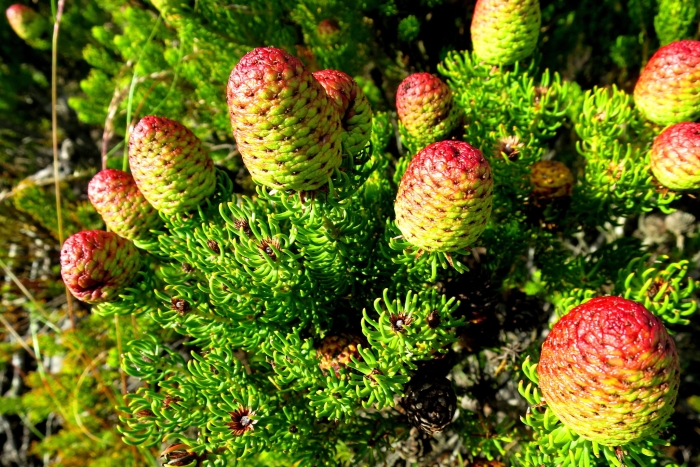Needle-Leaf Conebush
(Leucadendron teretifolium)
Needle-Leaf Conebush (Leucadendron teretifolium)
/
/

Di Turner
Public Domain
Image By:
Di Turner
Recorded By:
Copyright:
Public Domain
Copyright Notice:
Photo by: Di Turner | License Type: Public Domain | License URL: http://creativecommons.org/publicdomain/zero/1.0/ | Rights Holder: Di Turner | Publisher: iNaturalist | Date Created: 42655 |



















































Estimated Native Range
Summary
Leucadendron teretifolium, commonly known as the Needle-Leaf Conebush, is an evergreen shrub native to the fynbos region of Southwestern South Africa, characterized by heathland, shrubland, and renosterveld. This unique shrub typically grows to about 1 meter (3.3 feet) tall and is adapted to a Mediterranean climate with wet winters and dry summers. The Needle-Leaf Conebush has a striking appearance with its needle-like foliage and bears yellowish flowers from August to September, which are not particularly showy but are interesting for their conical shape. The plant is dioecious, with separate male and female plants, and relies on wind pollination.
The Needle-Leaf Conebush is valued for its drought tolerance and architectural form, making it a suitable choice for xeriscaping, rock gardens, and Mediterranean-themed landscapes. It is also used in floral arrangements for its unique foliage and cones. Cultivation requires full sun exposure, low water once established, and well-draining, acidic to neutral soils. It is not a heavy feeder but can benefit from occasional fertilization with a low-phosphorus formula. Fire ecology is central to its life cycle, as it is a pyrophyte; fires destroy the adult plants, but the seeds are protected in serotinous cones that release seeds post-fire, allowing for regeneration. Gardeners should be aware that this plant may require protection from frost and is susceptible to root rot in poorly drained soils.CC BY-SA 4.0
The Needle-Leaf Conebush is valued for its drought tolerance and architectural form, making it a suitable choice for xeriscaping, rock gardens, and Mediterranean-themed landscapes. It is also used in floral arrangements for its unique foliage and cones. Cultivation requires full sun exposure, low water once established, and well-draining, acidic to neutral soils. It is not a heavy feeder but can benefit from occasional fertilization with a low-phosphorus formula. Fire ecology is central to its life cycle, as it is a pyrophyte; fires destroy the adult plants, but the seeds are protected in serotinous cones that release seeds post-fire, allowing for regeneration. Gardeners should be aware that this plant may require protection from frost and is susceptible to root rot in poorly drained soils.CC BY-SA 4.0
Plant Description
- Plant Type: Shrub
- Height: 3-5 feet
- Width: 2-3 feet
- Growth Rate: Moderate
- Flower Color: Red, Brown
- Flowering Season: Winter, Spring
- Leaf Retention: Evergreen
Growth Requirements
- Sun: Full Sun
- Water: Low
- Drainage: Fast
Common Uses
Bee Garden, Drought Tolerant, Low Maintenance, Showy Flowers
Natural Habitat
Fynbos region of Southwestern South Africa, characterized by heathland, shrubland, and renosterveld
Other Names
Common Names:
Scientific Names: , Leucadendron teretifolium, Leucadendron abietinum, Chasme teretifolia, Protea revoluta, Protea teretifolia,
GBIF Accepted Name: Leucadendron teretifolium (Andrews) I.Williams